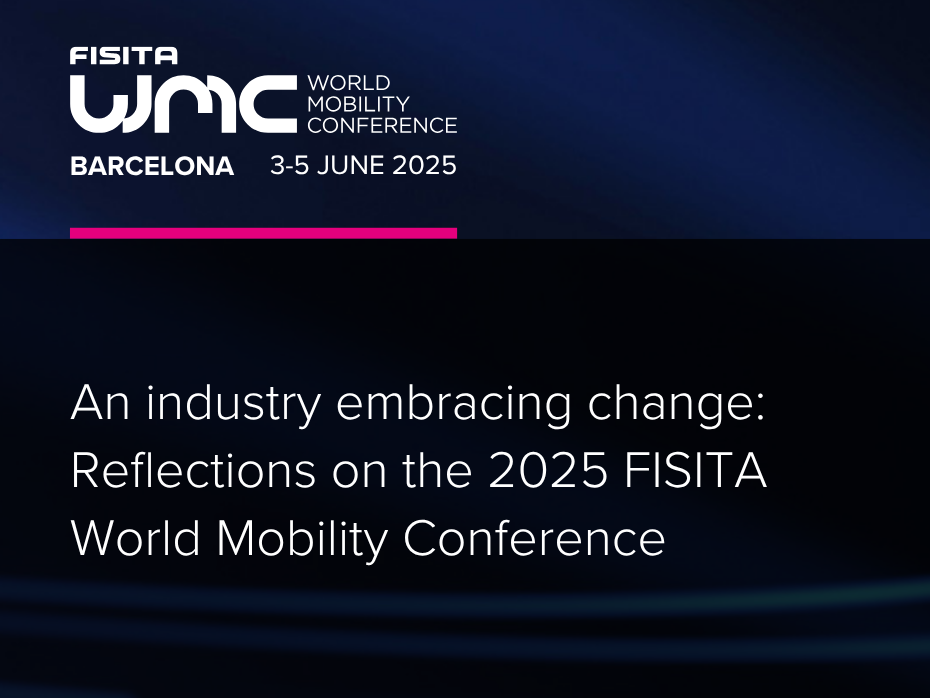The automotive industry is shifting through a revolution of technologies, with changes not only to the vehicles that make up the mobility ecosystem, but also the tools and approaches to developing the vast array of solutions helping firms aim for carbon neutrality.
The 2025 FISITA World Mobility Conference in Barcelona was a hub of knowledge exchange, opinions, and debate—timely, as the automotive industry faces some of its biggest challenges in decades.
The stage was set by Jose Manuel Barrios, member of the FISITA Executive Board and President of the Spanish Society of Automotive Engineers: “This transformation is marked by electrification, placing sustainability at the centre of our decision-making process, and attendees will help forge the collaboration needed to face the challenges.”
Each of the conference’s seven topic streams dug deeper into how the automotive industry will meet the ever-shifting demands placed on it to make mobility open to everyone.
The overriding theme at the 2025 FISITA World Mobility Conference was that the rapid rate of change is being embraced, changing approaches and powering almost every aspect of the mobility ecosystem
The starting point is nearly always policy and regulation. Often seemingly arbitrary national, regional, and international targets set the direction of travel for the industry and the tireless work of engineers. But the necessary framework of regulation isn’t always in place, making targets more challenging for the sector to meet, and narrowing the routes to improving sustainability.
“We want to become carbon and climate neutral,” said Dr Stephan Neugebauer, Director Global Research Cooperation at BMW Group. “Do we have the regulation in place? No. We have automotive regulations to become zero emission, but that means the regulation isn’t technology-neutral because there are only two options: EVs or hydrogen.” Neugebauer, who chairs the European Road Transport Research Advisory Council (ERTRAC), was speaking during a lively debate on the impact of regulatory policies on propulsion system innovations.
Even without the clarity the industry would like, automakers and suppliers are working hard to ensure everything the industry does is directed towards improving efficiency—no matter the region—and battery technology is at the heart of future success.
The entire battery supply chain is working to develop chemistries that will power future transportation and meet the key drivers to mass market adoption: cost, energy density, recharge times, and sustainability. And this needs to be possible whether through continuing improvements to mainstream technologies, including NMC and LFP batteries, the introduction of LMFP, or other battery chemistries that offer even better cost-performance benefits.
Artificial intelligence (AI) has captured the imagination of the wider public with technologies including ChatGPT and DeepSeek, but AI is a powerful technology that could revolutionise every part of mobility
But integrating high-value, resource-dense technologies into automotive applications creates another challenge for the industry: how to make mobility truly sustainable and part of a circular economy.
Many firms have stated goals of becoming carbon neutral in the next two decades, but that will only be possible if the industry works together; the necessary supply chain is often longer than many realise, and it’s only through collaboration that carbon neutrality can even be considered.
There is a real drive to achieve neutrality; companies including Toyota, Geely, The Future is Neutral (the company established by Renault Group), and Bosch realise the enormous benefits, not only to the environment, but more pragmatically, the bottom line.
Bosch’s Director of Operational Sustainability, Peter Lukassen, said, “We won’t have a sustainable future without a circular economy, so in the end it’s mandatory, but we see it as a multi-billion-dollar business.”
Key to success is the application of new approaches—both Toyota and The Future is Neutral will help recycle other brands’ vehicles and technologies—and designing from the beginning for sustainability. New approaches and tools will be critical, and leveraging new technologies was a thread that underpinned the entire World Mobility Conference.
Integrating high-value, resource dense technologies into automotive applications creates another challenge for the industry: how to make mobility truly sustainable and part of a circular economy
Artificial intelligence (AI) has captured the imagination of the wider public with easily accessible products such as ChatGPT and DeepSeek, but AI is a powerful technology that could revolutionise every part of mobility. The key is to ignore the consumer electronics chatbots and delve deeper into machine learning and neural networks to benefit development programmes.
AI-enhanced embedded systems are taking automotive into a new era of development. This includes the improvement of powertrain control, predictive maintenance to reduce vehicle downtime, validating automated driving systems, improving component durability and design, and leveraging AI to improve CAE tools.
Automakers and automotive suppliers are often known for evolution, but the rapid rate of change across the mobility sphere has turned the industry on its head and instigated a revolution. The overriding theme at the 2025 FISITA World Mobility Conference was that this rate of change is being embraced, changing approaches and powering almost every aspect of the mobility ecosystem.
James Scoltock is an independent writer and FISITA contributor
